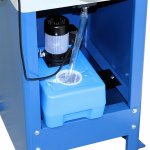projectnut
Stainless
- Joined
- Mar 4, 2006
- Location
- Wisconsin
I purchased a used Baileigh CS-350-EU cold saw earlier this year. It's now cleaned, repaired and working in the shop. While it hasn't gotten a ton of use it seems to be quicker and more accurate than either the horizontal bandsaw or the power hacksaw. The only "downsides" I see so far are noise and swarf accumulation.
Unlike the other style saws there isn't a convenient place for the swarf to accumulate and be easily removed. It piles up on the vise and table, and eventually needs to be removed by hand. At this point I've dedicated a shop vac to the saw to avoid brushing and spreading it all over the place. After a few cuts I just vacuum off the vise and table. It slows down the process a bit but keeps the swarf and coolant from being tracked all over the shop.
As for noise it seems this style saw is in general louder than the other styles mentioned, and closer to an abrasive cutoff saw. So far, I haven’t had problems with chatter or blade tracking. The machine cuts relatively true with cut stock between .0005” and .001” thicker at the bottom of the cut than at the top. The blade tracking can be adjusted using an eccentric on the head pivot. However, at this point I would have a hard time believing I could get it any more accurate.
Since this is the first and only true cold saw I've owned and used it got me to thinking about other brands cold saws in general, and more specifically how they handle swarf. In general, I'm wondering where the saw I have would rank as far as quality of build, and ease of use. I'm thinking that when considering purchase price, it would rank somewhere near the lower end. The new in the box price is slightly less than $6,000.00 while some other brands of similar size have a list price in the $9,000.00 to $12,000.00 range. I’ve even run across a few that list in the $15,000.00+ range. To be fair I’m not sure how “list price” actually relates to the final sale price. Are the more expensive saws sold at or near their list, or are they “discounted” to make the customer feel like they’ve gotten a good deal?
I’m hoping those with more experience with this style saw can give some insights as to any possible significant differences between the Baileigh saws and other more expensive brands.
Unlike the other style saws there isn't a convenient place for the swarf to accumulate and be easily removed. It piles up on the vise and table, and eventually needs to be removed by hand. At this point I've dedicated a shop vac to the saw to avoid brushing and spreading it all over the place. After a few cuts I just vacuum off the vise and table. It slows down the process a bit but keeps the swarf and coolant from being tracked all over the shop.
As for noise it seems this style saw is in general louder than the other styles mentioned, and closer to an abrasive cutoff saw. So far, I haven’t had problems with chatter or blade tracking. The machine cuts relatively true with cut stock between .0005” and .001” thicker at the bottom of the cut than at the top. The blade tracking can be adjusted using an eccentric on the head pivot. However, at this point I would have a hard time believing I could get it any more accurate.
Since this is the first and only true cold saw I've owned and used it got me to thinking about other brands cold saws in general, and more specifically how they handle swarf. In general, I'm wondering where the saw I have would rank as far as quality of build, and ease of use. I'm thinking that when considering purchase price, it would rank somewhere near the lower end. The new in the box price is slightly less than $6,000.00 while some other brands of similar size have a list price in the $9,000.00 to $12,000.00 range. I’ve even run across a few that list in the $15,000.00+ range. To be fair I’m not sure how “list price” actually relates to the final sale price. Are the more expensive saws sold at or near their list, or are they “discounted” to make the customer feel like they’ve gotten a good deal?
I’m hoping those with more experience with this style saw can give some insights as to any possible significant differences between the Baileigh saws and other more expensive brands.





